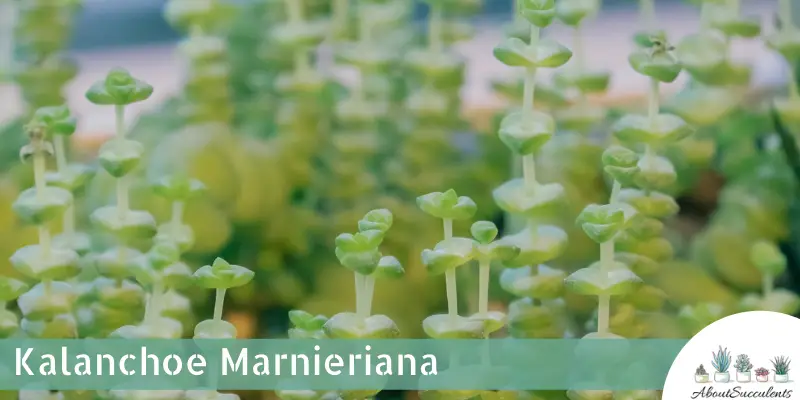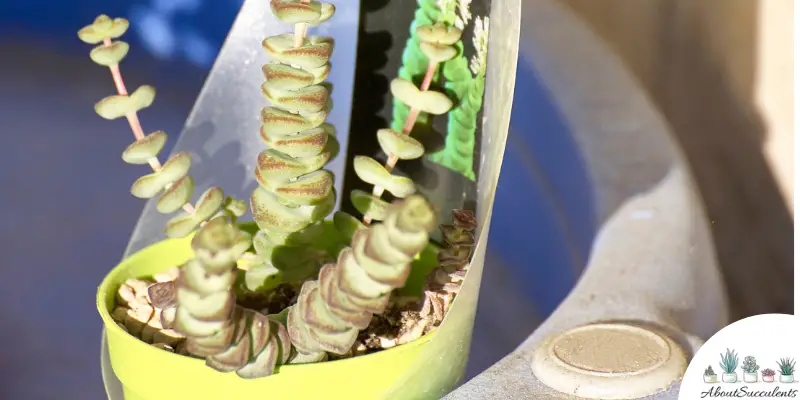
Kalanchoe Marnieriana which might be referred to as Marnier’s Kalanchoe or Kalanchoe de Marnier is an upright, robust succulent that grows into a dense succulent shrub.
It has blue-green leaves that grow opposite of each other as they move upwards the stem which can reach a height of 30cm to 45cm (12” to 18”) and 60cm to 90cm (24” to 36”) wide.
As the leaves move up and towards the tips of the branches, they give the succulent subshrub the appearance of having pages of a book.
The edges of Kalanchoe Marnieriana turn wine red when exposed to bright sunlight during the winter season. This is a summer dormant succulent plant that blooms rose-pink to red flowers during the winter which rises above its pink foliage.
Kalanchoe Marnieriana originates from the rocky areas northeast Madagascar. It is part of the Kalanchoe genus from the Crassulaceae family.
General Information:
Also known as: Marnier’s Kalanchoe
Plant Family: Crassulaceae
Origin: Madagascar
Height: 30cm to 45cm (12” to 18”)
Exposure: Partial Sun
Water Needs: Drought-resistant; only water when the soil is completely dry.
Soil Type: Standard potting mix with organic ingredients and sand, pumice, perlite, and clay to improve drainage.
Soil pH: 5.6 to 6.2
How to Grow and Care for Kalanchoe Marnieriana

Kalanchoe Marnieriana is a succulent plant that’s very easy to grow and care for. Horticulturists use Marnier’s Kalanchoe to create a mesmerizing vertical accent in container gardens.
This isn’t a cold-hardy plant and grows better in temperatures of -6.7° C (20° F). The good news is that Kalanchoe Marnieriana can be grown indoors or outdoors.
Sunlight
When planted in an outdoor garden, look for a location where Marnier’s Kalanchoe gets 5 to 6 hours of partial sun in the early morning or in the late afternoon.
Exposure to direct sunlight will burn its leaves. Lack of exposure will result in etiolation, a condition where the leaves become thin as they stretch out in search of sunlight.
As an indoor plant, place the succulent near a window that gets indirect sunlight for 5 to 6 hours. During the wintertime, the best indoor location would be a window that’s facing south.
Watering
Marnier’s Kalanchoe is a drought-resistant succulent and can survive long periods without water.
Before watering, check if the soil feels dry to the touch. You can insert a stick into the topsoil to test if there’s still moisture. Kalanchoe Marnieriana can only be watered when the soil is completely dry.
When watering, give the soil a good soak. Avoid overwatering as it can cause the roots to rot. Water the soil, not the succulent plant.
The rule is to water more frequently in the summertime as the soil tends to dry out faster and water less during the winter because the soil remains moist much longer.
Pot and Soil
The best pot to use for Kalanchoe Marnieriana is one that’s made of ceramic or terracotta and has good drainage. Ceramic and terracotta allow moisture to evaporate faster.
If you buy the succulent from a garden shop, it might be housed in a glass or plastic pot. Remove Marnier’s Kalanchoe and transfer it into a ceramic or terracotta pot when you get home.
The ideal soil mix for Kalanchoe Marnieriana is lush with organic ingredients and combined with clay, pumice, perlite, and sand to improve drainage.
The soil can provide the necessary nutrients but you may add liquid fertilizer during the summer to give it a nice growth boost.
How to Propagate Kalanchoe Marnieriana
If you want to grow more Marnier’s Kalanchoe, you can propagate the succulent using 2 methods: Stem or leaf cuttings.
Method 1 – Stem Cuttings Method
Step 1: Choose a healthy-looking stem.
Step 2: Cut the stem from the main plant by using a sterilized and sharpened knife or garden shears.
Step 3: Place the stem cutting on a dry and warm area and allow it to develop hard calluses for 2 to 3 days.
Step 4: Place the callused stem cutting on top of standard potting mix with coarse sand.
Step 5: The best location for the pot would be an area that receives partial sunlight. Mist the soil 4 to 5 times a day.
Method 2 – Leaves Cuttings Method
Step 1: Choose a healthy leaf without signs of disease.
Step 2: Remove the leaf from the stem by using a sharpened and sterilized pair of garden shears or a knife. Make sure no part of the leaf is left on the stem to ensure a successful propagation.
Step 3: Place the leaf cuttings on a warm and dry area and allow it to develop hard calluses for 2 to 3 days.
Step 4: Place the callused leaf cuttings on a standard potting mix with coarse sand.
Step 5: Position the pot near a window that gets partial sunlight and mist the soil 4 to 5 times a day.
Frequently Asked Questions
Is Kalanchoe Marnieriana Toxic to Cats and Dogs?
Kalanchoe Marnieriana does not appear in the list of plants that are toxic to cats and dogs on the website of the American Society for the Prevention of Cruelty to Animals (ASPCA).
However, this is just a partial list and Kalanchoe contains cardiac glycosides that are known to be harmful to animals. We recommend keeping pets away from Marnier’s Kalanchoe.
Why Is My Kalanchoe Marnieriana Dying?
If your Kalanchoe Marnieriana is not looking well and has signs of disease, there could be 2 causes of this.
Overwatering
Giving Kalanchoe Marnieriana water before its soil has completely dried out will cause its roots to rot which leads to the growth of fungi.
The fungi can quickly spread throughout the plant unless you act and remove the infected areas right away.
Cut out the diseased parts of the plant with a sanitized and sharpened knife or scissors. Then, slowly remove Marnier’s Kalanchoe from the soil, shaking off excess bits of earth from its roots.
Examine the roots carefully and remove the rotting roots. Lay the plant in a warm and dry place while you prepare to repot.
Fill a ceramic or terracotta pot with fresh potting mix with coarse sand, pumice, perlite, and clay. Repot Kalanchoe Marnieriana and water only if the soil is completely dry.
Pest Infestation
Mealybugs and mollusks are attracted to Kalanchoe Marnieriana. These pests drain the succulent sap and can cause fungal infection. Spray the plant with neem oil or wipe the leaves with 70% isopropyl alcohol to remove these pests.
Marnier’s Kalanchoe also attracts snails and slugs that love to feast on its leaves. To keep snails and slugs away, place cracked eggshells or diatomaceous soil near the base of the plant.
Does Kalanchoe Marnieriana Produce Flowers?
Yes, Kalanchoe Marnieriana produces rose-pink to red bell-shaped flowers during the winter.
Last Updated on June 9, 2022 by Sofia Lara